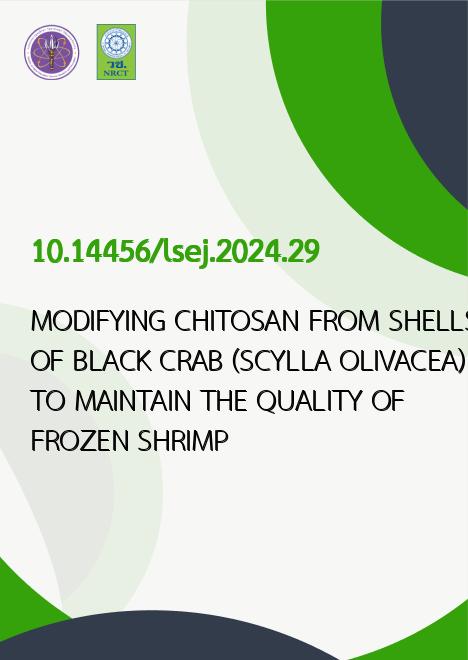
|
MODIFYING CHITOSAN FROM SHELLS OF BLACK CRAB (SCYLLA OLIVACEA) TO MAINTAIN THE QUALITY OF FROZEN SHRIMP |
|---|---|
| รหัสดีโอไอ | |
| Creator | Natta Kachenpukdee |
| Title | MODIFYING CHITOSAN FROM SHELLS OF BLACK CRAB (SCYLLA OLIVACEA) TO MAINTAIN THE QUALITY OF FROZEN SHRIMP |
| Contributor | Numphon Thaiwong, Tanayt Sinprachim, Supraewan Lohalaksanadech |
| Publisher | Pibulsongkram Rajabhat University |
| Publication Year | 2567 |
| Journal Title | Life Sciences and Environment Journal |
| Journal Vol. | 25 |
| Journal No. | 2 |
| Page no. | 380-395 |
| Keyword | modified crab shell chitosan;pentasodium tripolyphosphate;shrimp soak-ing solution |
| URL Website | https://ph01.tci-thaijo.org/index.php/psru/index |
| Website title | Life Sciences and Environment Journal |
| ISSN | 2773-9201 |
| Abstract | Soft-shell crabs are naturally occurring black crabs that grow through molt-ing, a process that leaves behind discarded black crab shells. The objectives of this research were to 1) produce chitosan from black crab shells and 2) study the appropriate type and concentration of crosslinkers: pentasodium tripolyphosphate (TPP), sulfate, and citrate at different concentrations of 1, 2, and 3% to modify chi-tosan from black crab shell and apply these modified chitosans as a soaking solution for Fenneropenaeus merguiensis (banana shrimp) before freezing. The results found that chitosan from black crab shells had a degree of deacetylation of 72.11±4.13% and a whiteness index of 70.13±0.98. Chitosan showed the water holding capacity, water solubility index, fat binding capacity, and swelling capacity equal to 1.07±0.28, 3.15±0.75%, 9.87±0.65 g/g sample, and 1.80±0.98 mL/g, respectively. The study exam-ined various parameters of frozen banana shrimp stored at -18°C for 6 months, in-cluding the production yield (% yield), thawing loss (% thawing loss), drip loss (% drip loss), pH, thiobarbituric acid value (TBA), total volatile base nitrogen (TVB-N), and trimethylamine (TMA). Samples treated with chitosan modified by TPP exhibited the best quality preservation among frozen food products. These treat-ments resulted in the lowest drip loss, measured at 0.55±0.18%. Furthermore, they demonstrated superior efficiency in inhibiting lipid oxidation, as evidenced by the lowest thiobarbituric acid content of 0.75 mg malonaldehyde/kg sample. |